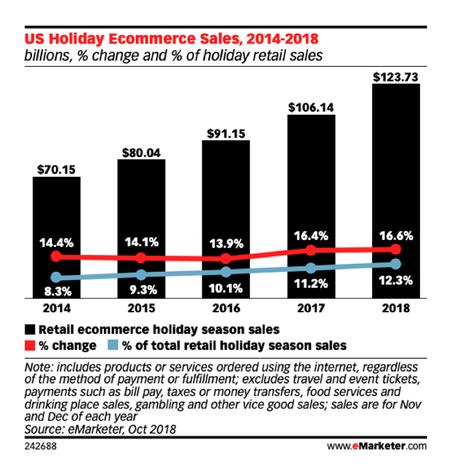Global spending hit some serious milestones in 2018. Customers dished out more than $1 trillion globally for their holiday items.

Black Friday and Cyber Monday continue to rise in popularity. Now, they're considered the two most popular days of online holiday shopping. In 2018, almost half of all holiday spending was done during Cyber Week.
So how can retailers make sure their website and marketing campaigns are up to par with increased shopping rates during the holidays?
In this piece, we'll look at the top best practices for retailers to use during the Q4 holidays. You'll discover tips to reach new customers, retain existing ones, and create differentiated experiences for both groups. In addition, we'll deep-dive into the technical bits - how can your site stay supported through an increase in traffic, and how can you decrease attrition while customers are in your shopping cart?
Let's dive in.
1. Treat mobile as its own experience.
Mobile commerce was expected to jump by 32.6% during 2018 - and Criteo reported that almost half of shopping on Black Friday was done via mobile phones.
It's safe to say that mobile and desktop shopping experiences are very different - due to the on-the-go nature of smartphones and the smaller screen size. Because of this, retailers should be wary of one-size-fits-all approaches to optimizing their visual storefront during the holidays.
Consider adding push notifications to your store app to make sure you're grabbing customers' attention. Be mindful of the amount and timing of these notifications - you don't want to annoy a customer.
Perhaps of the most importance on mobile is the checkout experience. Make your checkout process three steps or less, and consider adding additional payment gateways like PayPal and Apple Pay so that customers don't need to take their credit card out when they're on the go.
2. Don't forget about SEO.
Sometimes it takes a while to see the rewards of SEO, but you can get some quick wins to help drive traffic during the holidays.
Optimize for promotional keywords like "gift," "coupon," and "discount" in your product pages. Consider creating a gift guide that links to both yours and others' products, to help get a few backlinks.
For products that are seasonal, consider changing the title tag and description to include information about how they're a good gift for the holidays.
3. Personalize, personalize, personalize.
Holiday customers are smart. They know where to find discounts, they know how to research product quality, and once they're loyal to a brand they will return year after year until they're convinced otherwise.
So how do you capture a new customer and rise above the noise of your competitors? For many brands, they do this by adding personalized campaigns geared towards wherever the customer is in the shopping funnel, and whether or not they've purchased before.
Consider creating a buy-back campaign for customers who purchased from you last year. Remind them of their pleasant experience during the holidays and offer them a discount if they return.
For new customers, you'll need to nurture them into understanding more about your brand. Spend time highlighting glowing customer reviews, and keep in mind that they'll most likely be comparing your products to those of your competitors at every step of the way.
4. Take a look at your post-purchase experience.
Amongst a rising competitive holiday atmosphere, it becomes increasingly difficult to differentiate yourself from your competitors.
Many innovative brands look at their digital post-purchase strategy (such as follow-up emails, review solicitations, and scheduled retargeting) to combat higher customer acquisition costs.
But there is one other area that retailers should also look at - their fulfillment and packaging practices.
Shipping a package to a customer for the first time is considered their first physical touchpoint they have with your brand. Why not use this as an opportunity to showcase your story and stand out from a sea of brown boxes? Consider creating customized packaging in your brand colors, or having a fun unboxing experience with personalized tissue paper and add-ons.
Additionally, consider using sustainable packaging if that type of messaging is important to your brand. The decrease in fast-fashion paired with the increase in eco-friendly purchasing behavior makes "going green" a viable marketing tactic for many types of brands.
No matter what your packaging looks like, make sure it is also return-friendly. With a large amount of online purchases being returned during the holidays, make sure your packaging is durable and easy for customers to re-pack.
5. Prepare your on-site technology.
Your site needs to be prepared for an increase in shopper traffic. From a front-end perspective, your pages need to load quickly, your navigation should be intuitive, and your checkout should be secure and fast. On the back-end, try not to add any new tools or add-ons to your site right before the holidays in case things go awry.
Make sure to continuously test your website and your third-party integrations leading up to the holidays. Back up your data using a tool like Rewind.io, in case your site goes down due to a server error. And last but not least, make sure you have on-call or on-staff tech support available during the holidays to fix anything that comes up.
Conclusion
With these five main ideas, you'll be geared up and ready to drive real revenue during Q4. With online retail continuously rising, there are more and more opportunities to capture new customers and make sure they return throughout the year.

